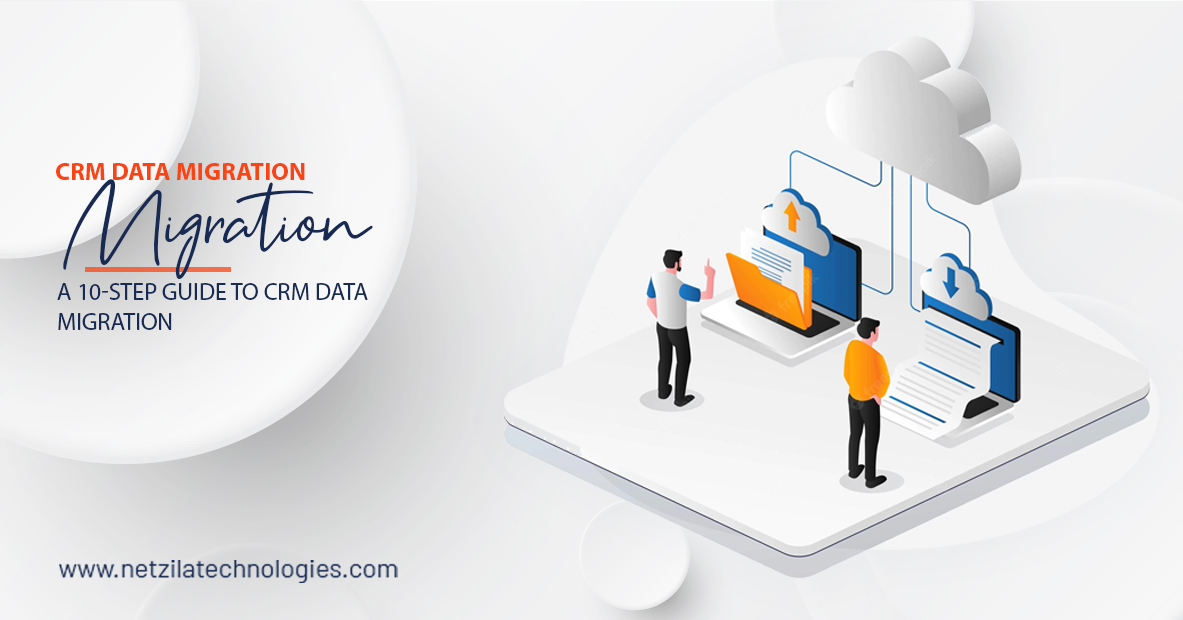Blog
A 10-Step Guide to CRM Data Migration

CRM Data Migration is perceived as dangerous since it might cause business interruptions, which is a significant barrier to considering the change. Taking the quantity of data you have at your disposal and cutting, copying, and pasting may appear to be a time-consuming and challenging task.
It’s like trying to relocate your home while avoiding harm to your belongings. Even if it gives you a headache, you must relocate as soon as the situation occurs, no matter what it takes. The transition will appear simple if you have a plan and a CRM migration strategy. So, one concern arises now: how to safely change CRM and migrate data? Let’s look at how to correctly conduct CRM data transfer in your firm.
10 Step CRM Data Migration Checklist Guide
1. Be Open To Change
The most important thing to do is to get your company ready for the transition. When employees have been using an existing data management system for a while and are familiar with it, it becomes difficult to convince them to switch to a new CRM program.
It is important for organizations to adopt an agile mindset. You’ll be able to accept, implement, and quickly adjust to change if you’re agile. It is crucial to initially take into account workforce training to acquaint them with the new CRM system while the migration is being carried out. This will guarantee rapid utilization effectiveness after the migration is finished.
2. List The Available Resources
CRM data migration must be treated as a separate project. It will enable you to maintain complete concentration throughout the migrating process. In this phase, the type of data you need to move will be highlighted.
Once the data pieces are defined, it is crucial to understand that the data structures need to be taken care of. You can store, arrange, track, and modify the data elements using a data structure. You may already vouch for a successful CRM data conversion if your company is able to move data structures to fit in the target CRM system!
A 360-degree review, where you must include any third-party integrations that are the inputs or outputs of a source CRM platform, is another crucial component. The level of changes made in the source CRM tool must then be adjusted without compromising the integrity of the data.
3. See The Attachments
Every business-related data collection contains a central hub of file attachments that make up additional data subsets. Planning for CRM data migration requires careful consideration of how to migrate attachments in an efficient manner. The additional task for your team is to determine the total file size and bring all the attachments together under one roof. The following step is analysis.
4. Doing A Data Quality Evaluation
To further understand this CRM data migration stage, let’s look at an example. When you relocate to a new home, you shift the possessions that are most important and get rid of anything that is no longer required. On the other side, you furnish your new home with new items to make it more attractive.
You must follow the same procedure here! Evaluate the previous data, maintain the most important information, and delete any entries that are redundant or superfluous. Doing a Data Quality Assessment is what this is known as.
5. Remember Data Mapping
While transferring data between CRMs, data mapping is crucial. It is crucial to know where your data should be stored after using the data transfer technique. Your CRM must have the data and pipeline journey for each prospect or customer. It is crucial to group or divide your CRM data into subsets. It guarantees that you can quickly and simply locate and evaluate the necessary data.
Consider the scenario of a data migration for a client, Peter. With your social media marketing strategy, you came across Peter. He is initially added to the category of “Potential customers.”
Peter’s data entry changed to the “loyal customers” group when he made the purchase following an enjoyable customer encounter. So, you must map them when you switch to the new CRM platform so that Peter enters the new & updated group rather than reflecting on the existing data entry group.
In a similar vein, it’s possible that Peter has a support window open. Ensure that the existing customer thread—which shows the active support window group with Peter’s entry—is carried over as part of your CRM data transfer plan.
You must accurately and consistently move data to the relevant associated groups. Additionally, it will make sure that data consistently transitions from group A of the old CRM to group A of the new CRM system.
Here are some things to think about when constructing a data map:
- identifying the data groupings that must be transferred
- examining the relevant data elements that belong to the relevant groups
- the format of the data once it has been relocated and being double-checked
- What procedures will you use for data transfer? Automatic or manual?
- The data transfer frequency required for a successful migration
- What modifications to the original CRM tool may have an impact on the data migration?
6. Choose The Best CRM Migration Tool
After completing the aforementioned requirements, you must finish the “anchor” tool so that your data may be imported into CRM.
The fact that this CRM data conversion solution will precisely automate the migration process is its strongest feature. Having a CRM data conversion service provider at your side would also be advantageous. Because even one flaw can cause you to start over.
Also, CRM data migration designers will assist you in developing a plan for error detection and recovery as well as in calculating the relocation.
Overall, everything would be sufficient for a flawless CRM conversion.
Dynamic CRM Data Migration-specific tools:
7. Make A Source Data Backup
It’s usually a good idea to develop a backup CRM migration strategy to protect against data loss concerns. Avoid falling into the trap if you believe you have a completely foolproof CRM migration project plan and can afford to get rid of the backup. While the conversion of your CRM data should happen without a hitch, you shouldn’t take the chance of losing any crucial data. Data backup makes sure you always have a copy of your data in case it gets lost or corrupted by mistake.
8. Execute Tests For Data Migration
A trial is always a good idea when confirming the legitimacy of the CRM migration solution. In conclusion, testing data migration is always a wise move.
You might never be able to predict how the data will be used in the new system. So, it is advised without thinking about the transfer all at once. Instead, transfer a little amount of data first and monitor the results. If there are any mistakes, it is best to correct them before the migration process is finished.
You should select a testing sample that includes practically all data groups and the various locations they will ultimately be in. It will enable evaluation of the general efficacy of CRM data migration testing.
9. Transfer CRM Data
When everything is in place, it is time to start carrying out the plan. Without a doubt, the moment has come to benefit from your CRM data migration efforts. It is the simplest stage, requiring only a “single-click” instruction to complete the conversion.
Note: If you properly completed the prior checklist prerequisites, there should be zero to minor errors.
10. Verify And Purge The Migrated Data
You must verify that the data was transferred correctly and clean up the system before using the new CRM solution on a regular basis. You can manually check arbitrary records, especially those that are crucial to your company. Ensure that the relevant information appears in those records. Verify any related information, such as the functionality of any attachments.
You can also choose a custom script that compares data in the new CRM system with data in your old CRM, depending on how crucial the data is. With large datasets, this can be time-consuming and expensive, but it will provide you peace of mind. Last but not least, go through the data to determine if there are any duplicate records, if anything needs to be merged, and if there is any material that can still be omitted.
Last Words:
These ten steps should enable you to successfully migrate your CRM, allowing you to benefit from your choice to implement a new CRM for your company.




